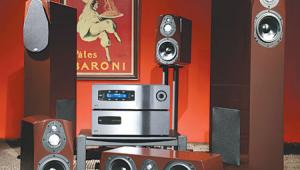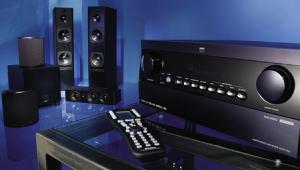KEF KHT6000 Speaker System and Arcam AVP700 Pre/Pro and P1000 Amplifier HT Labs Measures: Arcam

Analog frequency response in Stereo Direct mode:
+0.10dB at 10 Hz; +0.05 dB at 20 Hz;
–0.12 dB at 20 kHz; –0.79 dB at 50 kHz
Analog frequency response with signal processing:
–0.47 dB at 10 Hz; –0.11 dB at 20 Hz;
–0.16 dB at 20 kHz; –51.59 dB at 50 kHz
The above chart shows the frequency response of the left (aqua), center (green), LFE (purple), and left surround (red) channels at the preamp outputs of the Dolby Digital decoder. The left channel measures +0.03 decibels at 20 hertz and –0.07 dB at 20 kilohertz. The center channel measures +0.03 dB at 20 Hz and –0.04 dB at 20 kHz, and the left surround channel measures +0.04 dB at 20 Hz and –0.04 dB at 20 kHz. The LFE channel, normalized to the level at 40 Hz, is +0.04 dB
at 20 Hz, reaches the upper –3-dB point at 115 Hz and reaches the upper –6-dB point at 118 Hz.
Response from the multichannel input to the main output measures +0.10 dB at 10 Hz, +0.05 dB at 20 Hz, –0.12 dB at 20 kHz, and –0.73 dB at 50 kHz. The analog THD+N is less than 0.083 percent at 1 kHz with a 100-millivolt input and the volume control set to 78. Crosstalk with a 100-mV input was –81.93 dB left to right and –79.60 dB right to left. The signal-to-noise ratio with a 100-mV input from 10 Hz to 24 kHz with "A" weighting was –112.68 dBrA.—MJP
HT Labs Measures: Arcam P1000 Amplifier

All channels driven continuously into 8-ohm loads:
0.1% distortion at 165.8 watts
1% distortion at 172.3 watts
Frequency response:
–0.04 dB at 10 Hz
–0.00 dB at 20 Hz
–0.19 dB at 20 kHz
–1.03 dB at 50 kHz
This graph shows that the P1000's left amplifier channel, with two channels driving 8-ohm loads, reaches 0.1 percent distortion at 219.2 watts and 1 percent distortion at 236.4 watts. Into 4 ohms, the amplifier reaches 0.1 percent distortion at 348.4 watts and
1 percent distortion at 367.5 watts. An input level of 77.09 millivolts was required to produce an output of 2.83 volts into an 8-ohm load, indicating an overall gain of +31.31 decibels using the RCA input. When using the XLR input, a level of 153.60 millivolts was required to produce an output of 2.83 volts into an 8-ohm load, indicating an overall gain of +25.32 dB.
THD+N from the amplifier was less than 0.007 percent at 1 kHz when driving 2.83 volts into an 8-ohm load using the RCA input. When using the XLR input under the same conditions, THD+N was less than 0.009 percent. Crosstalk at 1 kHz driving 2.83 volts into an 8-ohm load was –80.97 dB left to right and –99.26 dB right to left using the RCA inputs and –81.11 dB left to right and –100.78 dB right to left using the XLR inputs. The signal-to-noise ratio with 2.83 volts driving an 8-ohm load from 10 Hz to 24 kHz with "A" weighting was –103.65 dBrA using the RCA input and –101.33 using the XLR input.—MJP
- Log in or register to post comments























































